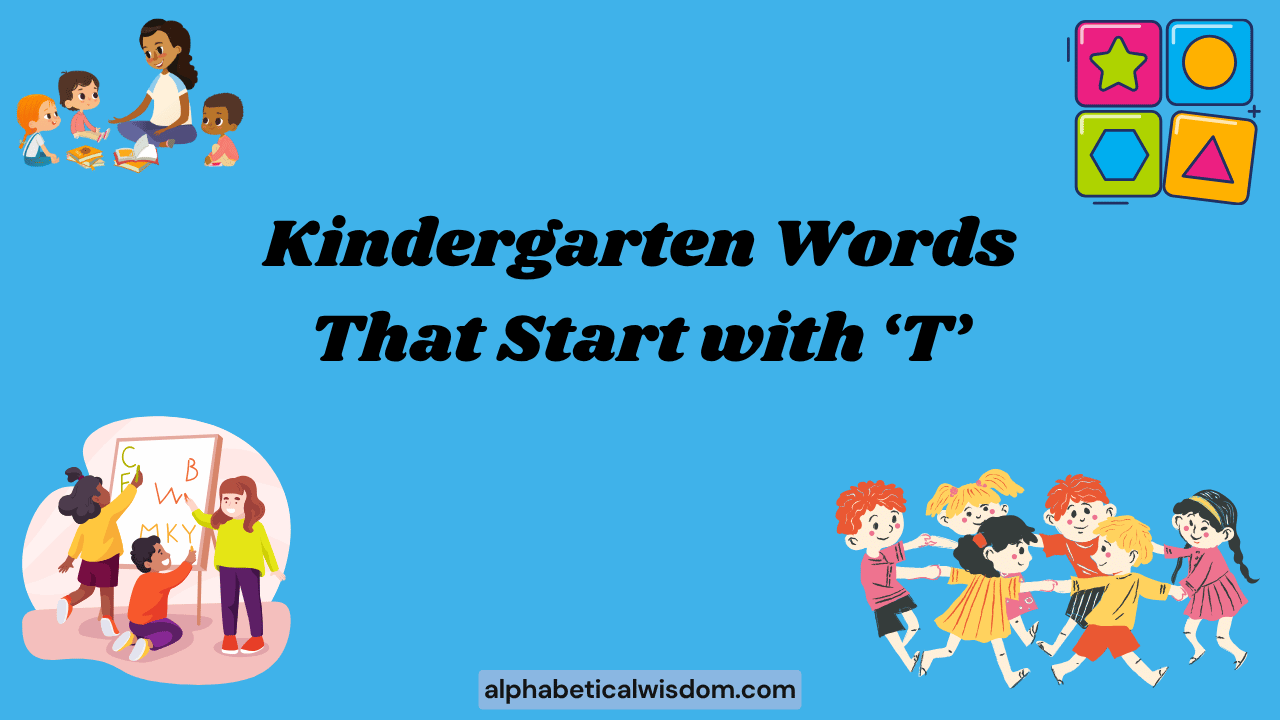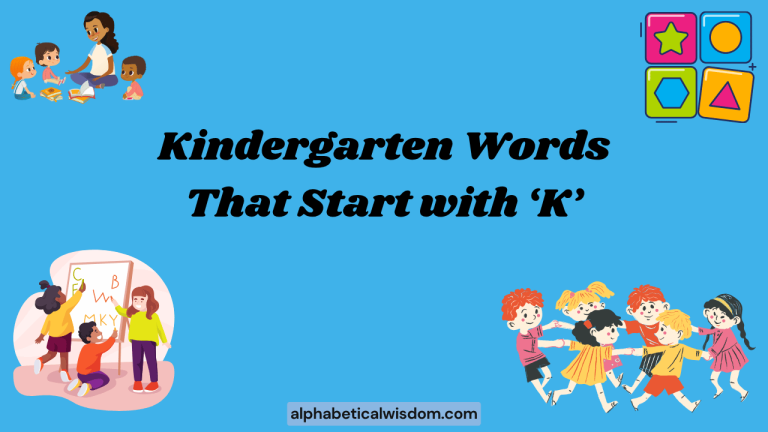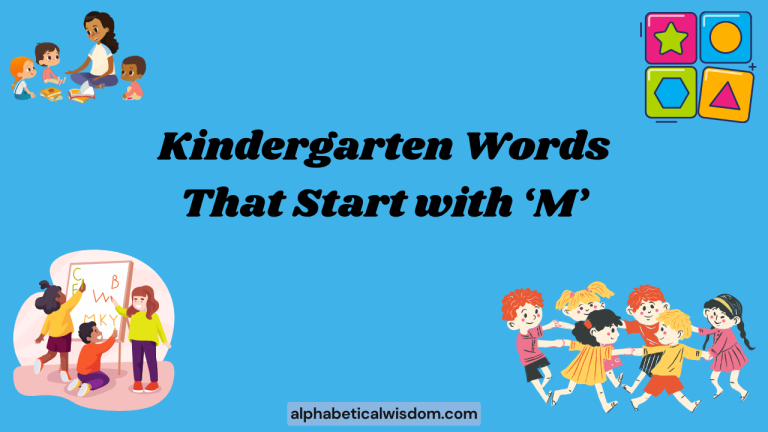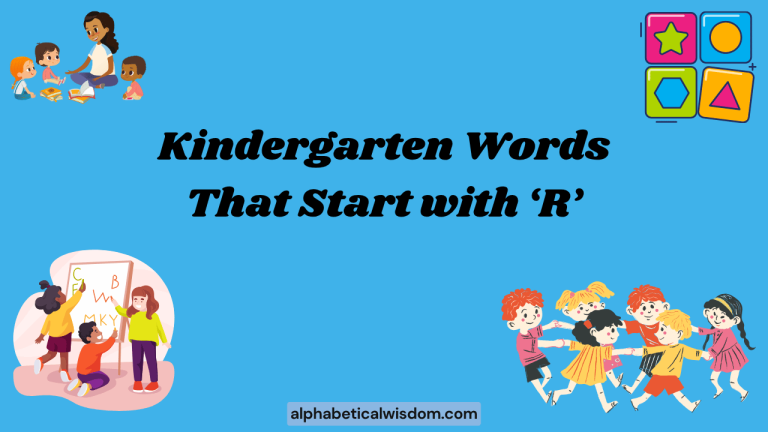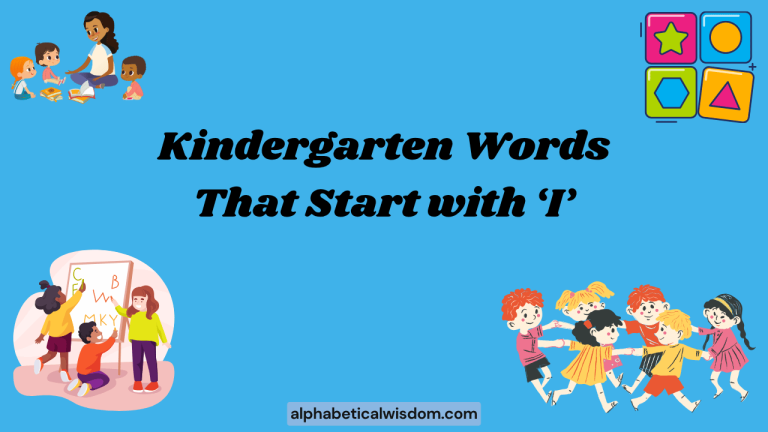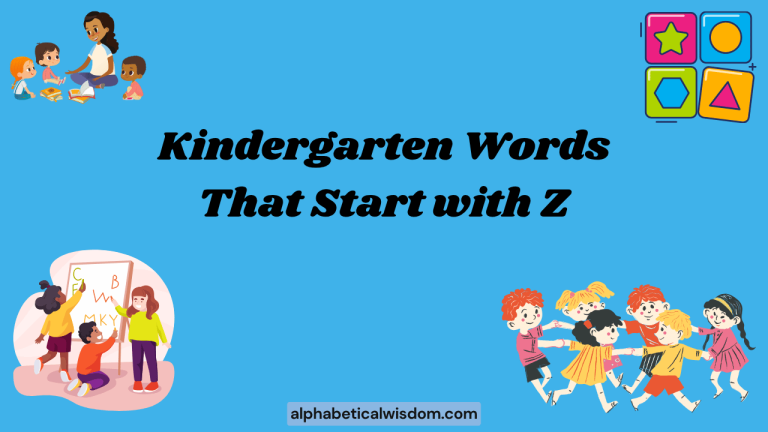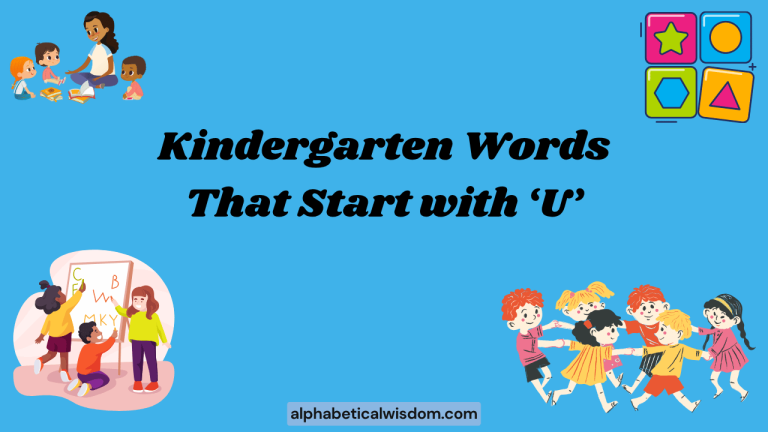Kindergarten Words That Start With T: A Comprehensive Guide
Understanding words that begin with the letter ‘T’ is fundamental for kindergarteners as they embark on their literacy journey. This skill enhances their vocabulary, reading comprehension, and overall communication abilities.
This guide provides a structured approach to learning these words, offering definitions, examples, and engaging exercises. Parents, teachers, and young learners alike will benefit from this comprehensive resource, designed to make learning fun and effective.
Mastering these words not only builds a strong foundation in English grammar but also fosters confidence in young learners as they begin to express themselves both verbally and in writing. By providing a variety of learning tools and activities, we aim to create an enjoyable and enriching experience for everyone involved.
Table of Contents
- Introduction
- Definition of Kindergarten Words That Start With T
- Structural Breakdown of Words Starting With T
- Types and Categories of ‘T’ Words
- Examples of Kindergarten Words That Start With T
- Usage Rules for ‘T’ Words
- Common Mistakes When Using ‘T’ Words
- Practice Exercises
- Advanced Topics
- Frequently Asked Questions
- Conclusion
Definition of Kindergarten Words That Start With T
Kindergarten words that start with ‘T’ are words commonly introduced to children in their kindergarten year to expand their vocabulary and enhance their early literacy skills. These words encompass various parts of speech, including nouns, verbs, and adjectives, and are chosen for their simplicity and relevance to a child’s everyday life.
The primary function of these words is to enable children to communicate effectively, understand simple texts, and build a strong foundation for future language learning.
These words are selected to be phonetically straightforward, making them easier for children to decode and pronounce. The context in which these words are presented is crucial, often involving visual aids, storytelling, and interactive activities to reinforce understanding and retention.
Introducing these words early on helps children develop confidence in their language abilities and prepares them for more complex linguistic concepts in later grades.
Structural Breakdown of Words Starting With T
Words starting with ‘T’ can be broken down into their basic phonetic components to aid in pronunciation and recognition. The letter ‘T’ is typically a voiceless alveolar stop, meaning it is produced by stopping the airflow with the tongue against the alveolar ridge (the area behind the upper teeth).
Understanding this articulation helps children pronounce the ‘T’ sound correctly. The structure of ‘T’ words often follows simple patterns relevant for early readers, such as consonant-vowel-consonant (CVC) or consonant-vowel (CV) structures.
For instance, the word “top” follows a CVC pattern, while “tea” follows a CV pattern. Recognizing these patterns helps children decode new words more easily.
The letter ‘T’ can also form digraphs, such as ‘th,’ which creates a different sound altogether. Understanding how ‘T’ combines with other letters to form new sounds is an important aspect of phonics instruction.
Furthermore, the position of ‘T’ within a word can slightly alter its pronunciation, which is important to address in early literacy lessons.
Types and Categories of ‘T’ Words
Kindergarten words that start with ‘T’ can be categorized into different parts of speech, each serving a unique function in sentence construction. These categories include nouns, verbs, and adjectives.
Recognizing these distinctions helps children understand how words work together to convey meaning. By learning to identify the different roles words play, children can begin to construct their own sentences with greater accuracy and creativity.
Nouns
Nouns are words that name people, places, things, or ideas. ‘T’ nouns commonly introduced in kindergarten are often tangible objects that children can easily relate to.
Examples include “table,” “toy,” “tree,” and “turtle.” These nouns are typically concrete, making it easier for children to visualize and understand their meaning. Learning these nouns helps children label and describe their environment, enhancing their descriptive language skills.
Verbs
Verbs are words that describe actions or states of being. ‘T’ verbs in kindergarten are usually simple and action-oriented, such as “talk,” “touch,” “take,” and “throw.” These verbs are often used to describe activities that children engage in daily.
Understanding these verbs helps children express their actions and participate more effectively in conversations. Introducing verbs early on encourages children to use dynamic language in their communication.
Adjectives
Adjectives are words that describe nouns, providing additional information about their qualities or characteristics. ‘T’ adjectives commonly used in kindergarten might include “tall,” “tiny,” “tasty,” and “tired.” These adjectives help children describe the attributes of objects and people around them.
Learning adjectives enhances their descriptive abilities and allows them to express their observations more vividly. Using adjectives enriches their vocabulary and adds depth to their language skills.
Examples of Kindergarten Words That Start With T
Providing numerous examples of ‘T’ words helps children grasp their meanings and usage in different contexts. These examples are categorized by parts of speech to facilitate understanding and application.
Each category includes a variety of words suitable for kindergarten-level learning. The following tables provide extensive lists of example words that children can learn and practice with.
Examples of Nouns Starting With T
The following table presents a list of nouns that begin with the letter ‘T,’ suitable for kindergarten-level vocabulary development. These nouns are common and easily relatable for young learners.
| Noun | Example Sentence |
|---|---|
| Table | We eat dinner at the table. |
| Toy | My favorite toy is a teddy bear. |
| Tree | The birds build nests in the tree. |
| Turtle | The turtle swims slowly in the pond. |
| Tent | We slept in a tent during our camping trip. |
| Tiger | The tiger is a large and powerful cat. |
| Tomato | I like to eat tomato with my salad. |
| Tooth | I brush my tooth every morning. |
| Train | The train travels on the railway. |
| Truck | The truck is used for transportation. |
| Team | The soccer team won the game. |
| Telephone | I use the telephone to call my mom. |
| Television | We watch cartoons on the television. |
| Thermometer | The nurse used a thermometer to check my temperature. |
| Thread | My mom uses thread to sew clothes. |
| Thumb | I hurt my thumb while playing. |
| Ticket | We need a ticket to enter the zoo. |
| Time | What time is it? |
| Toe | I stubbed my toe on the table. |
| Tongue | I use my tongue to taste food. |
| Tool | My dad uses tools to fix things. |
| Towel | I dry myself with a towel after a bath. |
| Town | I live in a small town. |
| Treasure | The pirates searched for the hidden treasure. |
| Trip | We went on a trip to the beach. |
Examples of Verbs Starting With T
This table showcases verbs that begin with the letter ‘T,’ providing examples of their usage in simple sentences suitable for kindergarten learners.
| Verb | Example Sentence |
|---|---|
| Talk | We talk to our friends at school. |
| Touch | Please don’t touch the hot stove. |
| Take | Can you take this book to the library? |
| Throw | He can throw the ball very far. |
| Taste | I want to taste the cake. |
| Tidy | Let’s tidy up our room. |
| Tell | I will tell you a story. |
| Thank | I thank you for the gift. |
| Think | I think it will rain today. |
| Tickle | I like to tickle my sister. |
| Tie | I can tie my shoelaces. |
| Tip | Don’t tip the glass over. |
| Toss | Let’s toss the ball. |
| Travel | We will travel to Paris next year. |
| Trek | We will trek in the mountains. |
| Try | Always try your best. |
| Train | We must train hard for the competition. |
| Translate | I can translate from English to Spanish. |
| Trap | They set out to trap the mouse. |
| Treat | I will treat everyone with respect. |
| Trim | My mom will trim the plants in the garden. |
| Trust | You can trust me to keep your secret. |
| Tune | I can tune the guitar. |
| Turn | It’s my turn to play. |
| Twist | I can twist the cap off the bottle. |
Examples of Adjectives Starting With T
The following table provides a list of common adjectives starting with the letter ‘T’ that are appropriate for kindergarten-level learners. These adjectives can be used to describe various nouns, enhancing vocabulary and descriptive language skills.
| Adjective | Example Sentence |
|---|---|
| Tall | The tall building reaches the sky. |
| Tiny | A tiny ant crawled on the ground. |
| Tasty | This cake is very tasty. |
| Tired | I am tired after playing all day. |
| Thankful | I am thankful for my family. |
| Thick | The thick book has many pages. |
| Thin | The thin paper is easy to tear. |
| Thoughtful | She is a thoughtful person. |
| Thorny | The rose has a thorny stem. |
| Tidy | My room is tidy after cleaning. |
| Tight | These shoes are too tight for me. |
| Timely | Your timely arrival was appreciated. |
| Tired | The baby is tired and needs to sleep. |
| Tolerant | We should be tolerant of others’ opinions. |
| Top | She is a top student in the class. |
| Tough | The assignment was very tough. |
| Toxic | The chemical is toxic and should be handled carefully. |
| Traditional | We had a traditional family dinner. |
| Tragic | It was a tragic accident. |
| Transparent | The glass is transparent. |
| Tremendous | The effort was tremendous. |
| Trendy | That is a trendy fashion style. |
| Tricky | The puzzle was very tricky. |
| Tropical | We are going to a tropical island for our vacation. |
| Trustworthy | He is a trustworthy friend. |
Usage Rules for ‘T’ Words
Understanding the usage rules for ‘T’ words involves knowing how to properly incorporate them into sentences based on their part of speech. Nouns are used as subjects or objects within a sentence.
Verbs describe actions and must agree with the subject in number and tense. Adjectives modify nouns and typically precede the noun they describe, or follow a linking verb.
Consistent practice and exposure to various sentence structures help solidify these rules.
It’s important to teach children about subject-verb agreement and the correct placement of adjectives. For example, “The tall tree” is correct, while “The tree tall” is not.
Similarly, verbs like “talk” need to be used in the appropriate tense, such as “I talk” (present tense) or “I talked” (past tense). By emphasizing these grammatical rules early on, children can develop a strong foundation in sentence construction.
Common Mistakes When Using ‘T’ Words
One common mistake is confusing the pronunciation of ‘T’ with ‘th,’ leading to mispronunciations. For example, saying “tree” as “three.” Another frequent error is using the incorrect tense of verbs, such as saying “I take” when the past tense “I took” is required.
Additionally, children sometimes misuse adjectives by placing them incorrectly in a sentence. Addressing these mistakes through targeted practice and repetition is essential for language development.
Here’s a table illustrating common mistakes and their corrections:
| Incorrect | Correct | Explanation |
|---|---|---|
| I taked the toy. | I took the toy. | Using the correct past tense form of ‘take.’ |
| The tree tall. | The tall tree. | Correct adjective placement before the noun. |
| I like too talk. | I like to talk. | Using the correct infinitive form ‘to talk.’ |
| I thanking you. | I thank you. | Using the correct present tense form of ‘thank.’ |
| He tired. | He is tired. | Including the linking verb ‘is’ with the adjective. |
Practice Exercises
Engaging in practice exercises is crucial for reinforcing the understanding of ‘T’ words. These exercises are designed to be interactive and fun, helping children apply their knowledge in different contexts.
The following exercises include fill-in-the-blanks, matching activities, and sentence completion tasks.
Exercise 1: Fill in the Blanks
Complete the following sentences with a suitable ‘T’ word from the options provided.
| Question | Options | Answer |
|---|---|---|
| The ______ is on the wall. | (table, clock, time) | time |
| I like to play with my ______. | (toy, tree, table) | toy |
| The ______ is very tall. | (tree, toy, table) | tree |
| The ______ swims in the water. | (tiger, turtle, town) | turtle |
| We sit at the ______. | (table, train, thread) | table |
| I brush my ______. | (town, tooth, tongue) | tooth |
| The ______ travels on the tracks. | (train, town, treasure) | train |
| We went on a ______ to the zoo. | (trip, treat, trick) | trip |
| I will ______ you a story. | (tell, tidy, thank) | tell |
| I ______ you for the gift. | (thank, think, throw) | thank |
Exercise 2: Matching
Match the ‘T’ word with its correct definition.
| Word | Definition | Answer |
|---|---|---|
| Table | A reptile with a shell | F |
| Toy | To express gratitude | H |
| Tree | A piece of furniture with a flat top | A |
| Turtle | A tall plant with a trunk and branches | C |
| Tall | A plaything | B |
| Tiny | To communicate verbally | G |
| Talk | Very small | F |
| Thank | Of great height | E |
Exercise 3: Sentence Completion
Complete the following sentences using the provided ‘T’ words.
| Sentence | Word Options | Answer |
|---|---|---|
| The ______ cat is sleeping. | (tired, tasty, tall) | tired |
| The cake is very ______. | (tasty, tiny, tall) | tasty |
| He is a ______ boy. | (thankful, tough, thoughtful) | thoughtful |
| The rose has a ______ stem. | (thorny, thin, thick) | thorny |
| My room is ______. | (tidy, tight, timely) | tidy |
| These shoes are too ______. | (tight, tiny, tired) | tight |
| The glass is ______. | (transparent, tragic, trendy) | transparent |
| The effort was ______. | (tremendous, tricky, tropical) | tremendous |
| That is a ______ style. | (trendy, tragic, transparent) | trendy |
| The puzzle was very ______. | (tricky, transparent, tropical) | tricky |
Advanced Topics
For more advanced learners, exploring compound words that begin with ‘T’ can be beneficial. Examples include “toothbrush,” “teacup,” and “tablecloth.” Understanding how these words are formed and used can further enhance vocabulary skills.
Additionally, exploring idioms and expressions that include ‘T’ words, such as “take it easy” or “turn over a new leaf,” can add depth to language comprehension. Analyzing the etymology of ‘T’ words can also provide insights into language evolution and cultural influences.
Delving into the nuances of pronunciation, such as the variations in the ‘th’ sound in words like “thin” and “this,” can refine phonetic awareness. Exploring literary devices, such as alliteration using ‘T’ words (e.g., “Tony the tiger took the train”), can encourage creative writing and language play.
These advanced topics offer opportunities for continued growth and a deeper appreciation of the English language.
Frequently Asked Questions
Here are some frequently asked questions about kindergarten words that start with ‘T’:
- Why is it important for kindergarteners to learn words that start with ‘T’?
Learning ‘T’ words helps expand their vocabulary, improves reading skills, and builds a strong foundation for future language learning. These words are often simple and relatable, making them easier for young children to grasp and use in everyday communication.
- What are some common ‘T’ words that kindergarteners should know?
Common words include table, toy, tree, turtle, talk, touch, take, tall, tiny, and tasty. These words are frequently used in children’s books and conversations, making them essential for early literacy.
- How can I make learning ‘T’ words fun for my child?
Use interactive activities such as flashcards, word games, and storytelling. Incorporate visual aids and hands-on experiences to reinforce understanding and retention. Make it a playful and engaging experience rather than a chore.
- What are some common mistakes children make when using ‘T’ words?
Common mistakes include mispronouncing the ‘T’ sound, confusing ‘T’ with ‘th’, using incorrect verb tenses, and misplacing adjectives. Addressing these errors through targeted practice and repetition is crucial.
- How can I help my child practice using ‘T’ words at home?
Encourage them to use ‘T’ words in their daily conversations. Read books together that feature these words. Play word games and create simple sentences using ‘T’ words. Provide a supportive and encouraging environment for them to practice.
- Are there any specific strategies for teaching the ‘th’ sound?
Use visual aids to demonstrate the correct mouth and tongue placement. Practice minimal pairs (words that differ by only one sound) such as “thin” and “tin” to help children distinguish the sounds. Use games and activities to make learning fun and engaging.
- How do I know if my child is struggling with ‘T’ words?
Look for signs such as difficulty pronouncing ‘T’ words, frequent misspellings, and hesitation when using these words in conversation. If you notice these signs, provide additional support and practice opportunities.
- How many ‘T’ words should a kindergartener know?
There is no set number, but introducing around 20-30 common ‘T’ words is a good starting point. Focus on quality over quantity, ensuring that the child understands and can use the words effectively.
Conclusion
Mastering kindergarten words that start with ‘T’ is a significant step in a child’s literacy development. By understanding the definitions, structures, and usage rules of these words, young learners can enhance their vocabulary, reading comprehension, and overall communication skills.
This comprehensive guide provides a structured approach to learning ‘T’ words, offering definitions, examples, and engaging exercises.
Remember to make learning fun and interactive by incorporating visual aids, storytelling, and hands-on activities. Consistent practice and a supportive learning environment are key to success.
Encourage children to use ‘T’ words in their daily conversations and celebrate their progress along the way. By investing time and effort in early literacy, you are setting the stage for a lifetime of learning and success.
